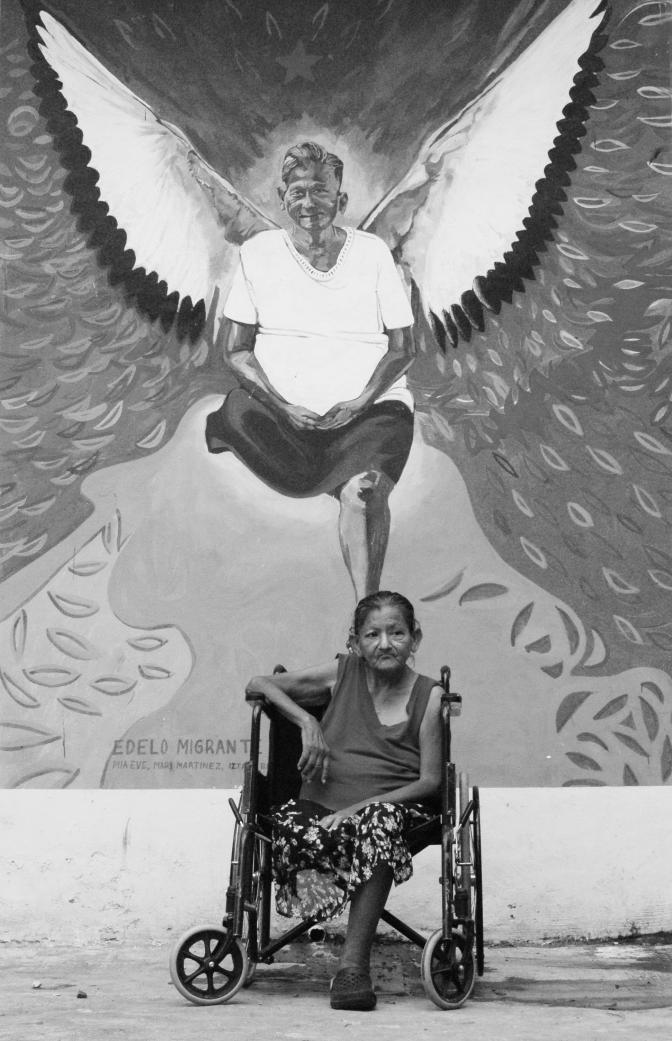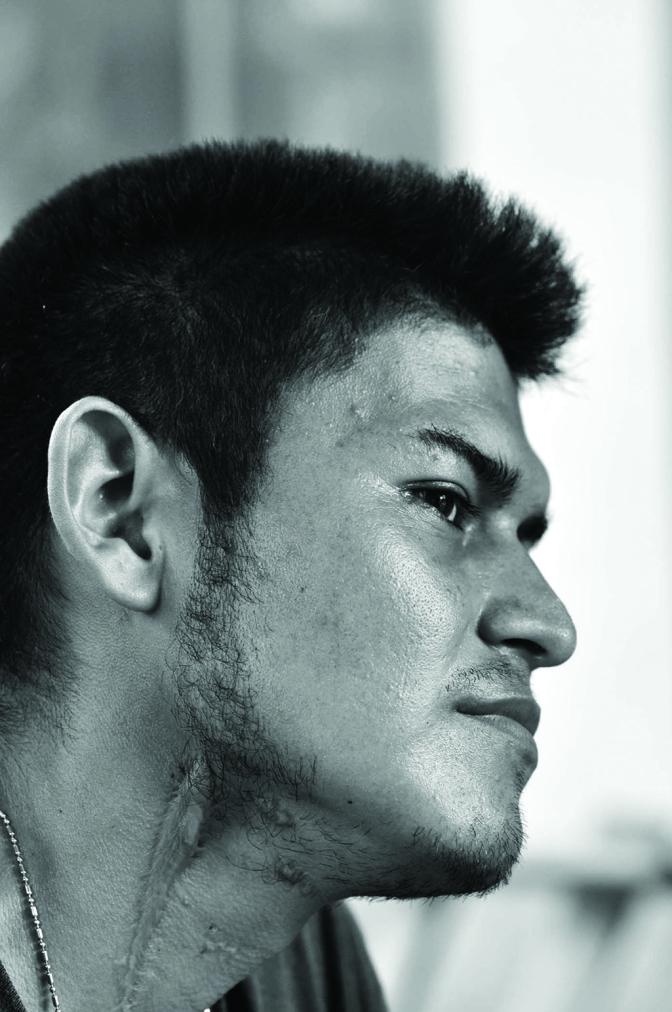Juan Alberto has lost both a son and grandson to the Mara Salvatrucha, one of the most vicious gangs in Latin America. The gang had tried to force the two young men to join; when they refused, they were kidnapped and killed. The rest of the family, afraid they, too, would be killed, fled Honduras in the middle of the night and ended up in Chiapas, Mexico’s southernmost state. Today Juan Alberto lives with his wife, two of their sons, and two young grandchildren in a large but mostly empty house in the city of Tapachula.
The house is on a dirt road, not far from the main thoroughfare. To get to it, one crosses a small bridge spanning a stagnant pool of water. Inside the front door is a large empty room. To the right are two small bedrooms with thin mattresses and sleeping bags on the floor. The kitchen is in the back, sparsely furnished with two small tables and a few plastic chairs. Santos Ermilia, Juan Alberto’s wife, cooks on a two-burner electric hotplate.
Like an increasing number of people fleeing the extreme violence of Guatemala, Honduras, and El Salvador (often referred to as the Northern Triangle Countries, or NTCs), Juan Alberto’s family have decided to apply for asylum in Mexico. They have little choice. “If we could, we would go to the United States,” Juan Alberto tells me. But he knows that traveling through Mexico is dangerous, and that getting asylum in the United States is extremely difficult, if not impossible. Going home isn’t an option. When I asked what would happen if they returned to Honduras, he smiled sadly and drew a finger across his neck. So they are resigned to staying in Mexico. “I am happy here because we are away from danger.”
On average, about four hundred thousand people from the NTCs enter Mexico each year. According to Francesca Fontanini, the United Nations High Commission on Refugees (UNHCR) Communications Director for Latin America, the number was closer to half a million in 2016. The number fell a little during the first four months of 2017—advocates called it the Trump Effect—but Fontanini says the numbers are increasing again. She expects another half million migrants to enter Mexico this year. The reason is simple: “The level of violence in Central America is still high.”
The Northern Triangle Countries, which are among the poorest in the world, are also among the most violent. Most years, one of them holds the top spot for murders per capita. Most of the violence is perpetrated by two gangs, the MS-18 and Mara Salvatrucha, often collectively referred to as maras. They murder, kidnap, and rape with impunity. People in the NTCs report having to pay the gangs as much as half their income in “renta” (extortion) so they can work. Some pay renta just to live in a neighborhood. When I ask why people don’t go to the police, Felix Antonio, a twenty-seven-year-old Honduran, offers the same answer I heard from every Central American I interviewed for this article: “The maras control everything. Police do nothing; they collaborate with maras.” Felix Antonio’s mother was killed by the maras (“God knows why,” he says) and he himself was stabbed in the neck, leaving him unable to use his left hand.

Until recently, the overwhelming majority of those who fled the NTCs tried to make it to the United States, but as it has become more dangerous to journey to the U.S.-Mexican border and more difficult to win asylum in the United States, more people are opting to stay in other countries, including Mexico. But obtaining asylum in Mexico is also difficult and, even if it is granted, many challenges remain.
Officially, it takes forty-five working days, or about two months, for an asylum application to be processed. For most, it takes much longer than that. According to Fontanini, the wait has recently stretched to at least six months. Once someone is granted asylum, he has the same rights as a Mexican citizen and is allowed to work; until then, he isn’t supposed to. But most asylum-seekers are poor and can’t afford not to work. So many take jobs in the informal economy. They “want some money, they want some dignity,” says Fontanini. “They work long hours [for] very bad pay.” Like undocumented Mexican workers in the United States, their legal status leaves them vulnerable to exploitation.
Josue was in the Honduran Air Force but left when the maras—both MS-18 and Mara Salvatrucha—threatened him because he was in the military. “It is dangerous to be a soldier in Honduras,” he tells me. Josue fled, leaving behind his wife and two young children. For much of the way north, he rode the freight trains they call La Bestia (the Beast). He was robbed of most of his money and is currently living in a shelter in Mexico City. There he works in construction while waiting for a decision on his asylum application. “I earn about 200 pesos a day (about $11) for ten hours of work,” he says. “Mexicans are paid more.” His story is echoed by another Honduran named Edilberto, who lived for a time in the same shelter and now has an apartment a short distance away. “There is prejudice against Central Americans and exploitation,” he says. “When you work without papers, you are paid less, maybe half.” Edilberto is now studying to be a chef, traveling two and a half hours each way to school. He plans to stay in Mexico. “Mexico is better now,” he says. “There is more possibility to live in freedom; there is no fear of maras.” Then he adds, “I have no other options, really.” Bryant, another young refugee from Honduras tells me, “I prefer to be hungry here than there, where they will kill me.”

The UN High Commission on Refugees considers the majority of people fleeing the Northern Triangle Countries to be fleeing “generalized violence” and therefore eligible for asylum. Mexico’s own immigration laws state that anyone fleeing generalized violence qualifies for asylum, but the Mexican government does not make it easy for refugees. Katherin Ramirez, an attorney at the CAFEMIN shelter in Mexico City, told me that 60 to 70 percent of all asylum applications from Central Americans are rejected. And while asylum status may make life less difficult, it does not make it easy. They are still newcomers, and still considered outsiders. They still have to build a new life from scratch. Migrants tend to gravitate to the larger cities, where there’s work. They often end up living on the outskirts of these cities, where there’s affordable housing. And so they often spend hours commuting from one part of a metropolis to another. Those who do manage to find jobs in the formal economy usually earn minimum wage, which is 80 pesos (about $4.44) a day. “There is not enough work—or work that pays enough money,” says Ramon Verdugo, director of the Todo Por Ellos shelter in Tapachula, Chiapas. “On minimum wage, people can live, but will live like many Mexicans: in a culture of poverty.”
Some Central Americans have found life here to be too difficult. “It doesn’t make sense to live in Mexico,” says Carlos Alberto, a professional soccer play who fled Honduras because of the violence. “It’s as violent here as in Honduras.” His plan is to work in Mexico until he has saved enough money to pay for a coyote to help him get to the United States. Sr. Chela, who works in the Samaritano shelter in Tula, Hidalgo, tells me that about 10 percent of the Central Americans she’s met eventually decide to return home. “Some, because of the violence in Mexico, will ask how to contact INM so they can be deported.” Deportation is the cheapest way home.
As dusk falls in Tapachula, Juan Alberto walks me from his home to the main road. We talk about his new life as I wait for a cab to take me back into town. He says the UNHCR is helping them “with rent and a little with food. Not all, but some.” One of his sons is working (illegally) in construction, earning 170 pesos (about $9) a day for ten hours of work. In addition to the family’s financial worries, there are the challenges of fitting into a new culture. When I ask Juan Alberto if he misses Honduras, he sighs: “Oh, so much. So much.” He starts describing the differences between the two countries—different customs, different foods, even different words. “You ask for something by the name we use in my country and they don’t understand you. I feel sad sometimes because I have nothing here. If there were no mara, we would still be in Honduras.”
Please email comments to [email protected] and join the conversation on our Facebook page.
Share
Previous Story
‘She Lived to Read’
Next Story
Poem | Ennui